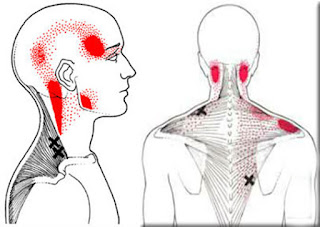Thoracic Vertebrae
Thoracic Vertebrae
The thoracic spine is part of the vertebral column that supports the chest area and provides posterior attachment for the ribs, some thoracic wall muscles, muscles of the upper limb abdomen and back. The thoraci spine lies between the cervical spine superiorly and the lumbar spine inferiorly. It consists of 12 thoracic vertebrae that are in some ways distinct from vertebrae found in other regions of the vertebral column
Bodies
The bodies of the thoracic vertebrae are medium sized and heart shaped. They are all weight bearing and generally increase in size from up downwards with an increase in the amount of weight that needs to be supported. The heads possess articular facets on their sides for articulation with the heads of the ribs
Pedicles
These project from the posterolateral surfaces of the bodies of the ribs and meet posteriorly with the laminae. The pedicles and laminae on either side form the neural arch which together with the posterior surface of the body enclose the vertebral formen. The pedicles are notched on their superior and inferior surfaces, in the articlated thoracic spine, these notches form the intervertebral foramina for the passage of the thoracic spinal nerves
Laminae
Run posteriorly from their junction with the pedicles and and meet in the posterior midline to form the spinous process of each thoracic veretebra
Transverse process
There are two for each veretebra, these are long and thin and provide an articular surface for the tubercle of the rib as well as attachment sites for ligaments and mucles of the thoracic region. They run laterally from the junction between the pedicle and the lamina on either side.
Articular processes
Each veretebra has a superior articular process on each side that has a smooth surface (articular facet) for articulation with the corresponding inferior articular facet of the inferior articular process of the superior vertebra. Each vertebra also has an inferior articulat process on either side that articulates with corresponding superior processes of the subjacent vertebra. Superior articular facets of the thoracis region face posteriorly and laterally, the inferior facets face forward and medially. This arrangement permits rotation to occure between the vertebrae
Vertebral canal
The body and neural arch of each vertebra enclose the vertebral foramen, in an articulated thoracic spine, the vertebral foramina of the stacked vertebrae form a continuous vertebral canal for the passage of the spinal cord and the meninges surrounding it, as well as the arteries and veins supplying these structures. In the thoracic spine, the vertebral foramina are small and circular and this has obvious implications on the spinal cord. The spinal cord in the adult terminates at or around the level of the lower border of the first lumbar vertebra meaning it traverses the entire thoracic spine. Slightly excessive movements of one vertebra relative to another in the thoracic region run a huge risk of compressing the spinal cord and leading to damage of the cord
Spinous process
The spinous processes of thoracic vertebra project posteriorly but mainly downwards. In palpation of the posterior midline in the thoracic region, it will be important to note that the tip of the thoracic spine will lie level with the body of the subjacent vertebra, for example, the spine of the seventh thoracic vertebra C7 will lie roughly at the level of the body of the eighth thoracic vertebra C8
Assessment
Thoracic eximantion includes a subjective and an objective part. The objective part is here divided in Physical Therapy assessment and diagnostic imaging.
Physical Therapy assessment
1. Active tests
a. Active movements. The active movements of the thoracic spine are usually done with the patient standing.
b. Auxiliary tests associated with active movements tests.
2. Passive tests
c. Movement of the pain-sensitive structures in the vertebral canal and intervertebral foramen.
d. Palpation.
e. Passive range or intervertebral movement. The joint play movements performed on the thoracic spine were developed by Maitland and they are: Posteroanterior central vertebral pressure, posteroanterior unilateral vertebral pressure, transverse vertebral pressure and rib springing.
Visual examination of abnormal postures
- Kyphosis: When the thoracic spine is viewed from the side, it is seen to have an anterior concavity and posterior convexity, and when looked at from behind, should theoretically descend in the postrior midline. In certain cases, such as in elderly people, the anterior concavity of the thoracic spine is exaggerated, and this is termedhyperkyphosis or age-related kyphosis. Kyphosis is a condition thata is most prevalent in the thoracic spine. The kyphotic individual presents with a stooped posture and this has implications on thoracic expansion.
Scheurman disease is the most commont structural kyphosis in adolescents but can occur in adults. Its etiology is unknow.
Hump back is a localized, sharp, posterior anagulation called a gibbus. This kyphotic deformity is usually structural and often results from an anterior wedging of the body of one or two thoracic vertebrae. Dowagers's hump results from postmenopausal osteoporosis: anterior wedge fractures occur to several vertebrae, usually in the upper to middle thoracic spine, causing a structural scoliosis that also contributes to a decreise in heigh.
- Scoliosis: The thoracic spine may also be curved laterally when viewed from behind. Usually there is a concavity to one side in the thoracic spine and a 'compensatory' concacity to the opposite side in the lumbar spine, and this may be considered
normal. However, in certain cases, these curvatures are exaggerated and this is termed scoliosis.Treatment
Physiotherapy
Exercise
Is beneficial in situations of kyphosis, osteoporosis, stiffness, etc. Among the different types of exercises we can name pilates, which could be effective for treating non-structural scoliosis. In a study of 2016 it was shown that both Schroth and Pilates exercises were effective in individuals with scoliosis, but the Schroth exercise was more effective.Manipulation
There is no much research literature on the safety of joint manipulation when applied to the thoracic spine. Thrust joint manipulation should never be performed when contraindications or precautions are present.







Comments
Post a Comment